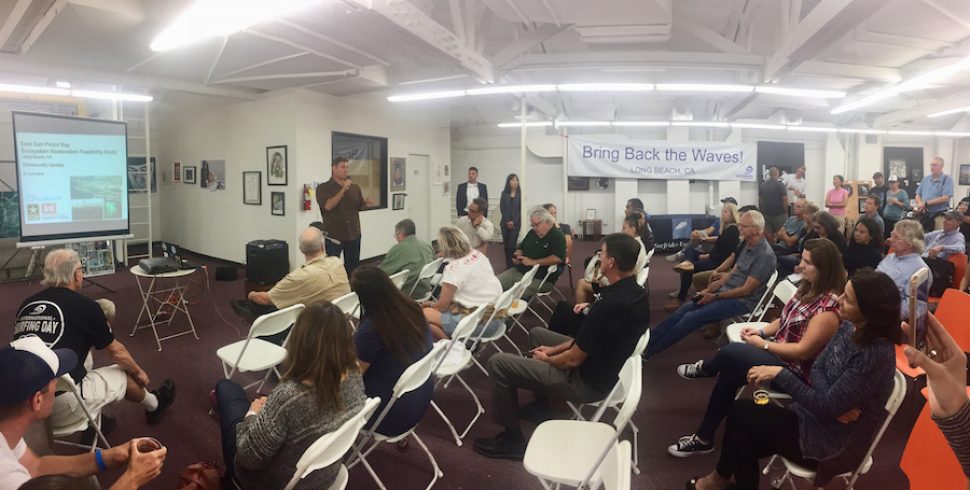A study that could determine the future of the Long Beach breakwater is approaching completion, but it’s unclear at this point whether the document will recommend removing or altering the breakwater, something local surf advocates have spent years pushing for with the hope of bringing waves back to the local coastline.
The U.S. Army Corps of Engineers, which has been working on the study since early 2016, gave a public update on its process Thursday night in downtown Long Beach. A draft version of the study could be revealed as soon as November, according to the Army Corp.
It will include up to five options to improve the ecosystem in the East San Pedro Bay, two of which the city has asked to include some option to address the breakwater. But many in the crowd Thursday night seemed stunned that the breakwater had taken a backseat to environmental issues.
“The corps doesn’t study breakwaters,” said Diana Tang, manager of government affairs for the city of of Long Beach. “They have several missions and one of them is ecosystem restoration.”
The meeting was hosted by the Long Beach chapter of the Surfrider Foundation, an advocacy group that wants to dismantle the breakwater. Its members hope waves will once again crash onto the shores of Long Beach, which was once dubbed the Waikiki of the West Coast.

Seamus Innes, of the Long Beach Surfrider Foundation, speaks to residents during a meeting to update the community on a study that could potentially reconfigure the city’s breakwater. Staff photo by Jason Ruiz.
Seamus Innes, a member of the group who has been deeply involved in the decades-long fight against the breakwater, said he’s hopeful the Army Corps does present a plan that includes bringing waves back.
He argued it would be a boon to local businesses and property values. He vowed that the fight won’t stop in November if the Army Corps’ report doesn’t include options to address the breakwater.
“The nice way to say it is to say that we’re going to dialogue with all involved parties,” Innes said. “The hard way to say it is we’re going to raise hell.”
When the study is complete, the Army Corp will choose a preferred plan.
“At this point modeling is essentially complete and there are several arrays that can be included,” Tang said. “Some of them include breakwater modification and some of them don’t, but what the city is asking for is as part of this [environmental review] process there is at least two that do consider the breakwater.”
United States Army Corps of Engineers Gives Green Light to Long Beach Breakwater Study
The City Council would also get to pick its own preferred alternative, and if the two choices match, the funding breakdown for construction would likely be 65 percent coming from the federal government and 35 percent coming from the city, according to officials.
Any cost overruns resulting from the city picking a different alternative than the Army Corps would likely be the city’s responsibility to cover.
Josh Hickman, the tidelands program manager with the city, had no answer as to where that funding would come from or how much the city would be willing or able to fund for any project alternative that is picked by the council.
Assemblyman Patrick O’Donnell, who hosts an annual paddle-out to memorialize the waves that once drew surfers and tourists to the city, was one of those unsatisfied with the possibility that only two options in the report would consider altering the breakwater.
“Hopefully it’ll be more than two,” O’Donnell said. “To me, just planting eelgrass is not going to cut it.”
O’Donnell’s comment about eelgrass was likely pointed at previous conversations that have focused on restoring the marine life habitat in the bottom of the bay by reintroducing plants to increase oxygen levels and food sources for other life forms to thrive.
[A previous version of this story attributed quotes to Eileen Takata, a watershed manager for the Army Corps. The story has been updated to attributed them to Diana Tang, the city’s manager of government affairs.]

